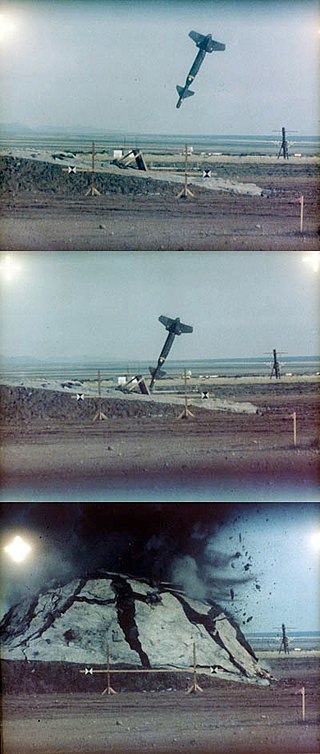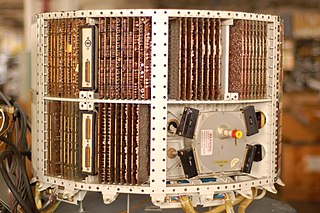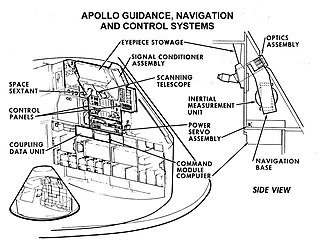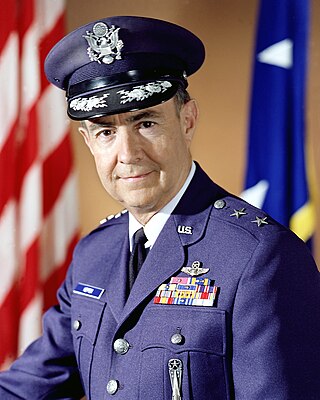
Avionics are the electronic systems used on aircraft. Avionic systems include communications, navigation, the display and management of multiple systems, and the hundreds of systems that are fitted to aircraft to perform individual functions. These can be as simple as a searchlight for a police helicopter or as complicated as the tactical system for an airborne early warning platform.

The LGM-30 Minuteman is an American land-based intercontinental ballistic missile (ICBM) in service with the Air Force Global Strike Command. As of 2024, the LGM-30G is the only land-based ICBM in service in the United States and represents the land leg of the U.S. nuclear triad, along with the Trident II submarine-launched ballistic missile (SLBM) and nuclear weapons carried by long-range strategic bombers.

North American Aviation (NAA) was a major American aerospace manufacturer that designed and built several notable aircraft and spacecraft. Its products included the T-6 Texan trainer, the P-51 Mustang fighter, the B-25 Mitchell bomber, the F-86 Sabre jet fighter, the X-15 rocket plane, the XB-70, the B-1 Lancer, the Apollo command and service module, the second stage of the Saturn V rocket, and the Space Shuttle orbiter.

Missile guidance refers to a variety of methods of guiding a missile or a guided bomb to its intended target. The missile's target accuracy is a critical factor for its effectiveness. Guidance systems improve missile accuracy by improving its Probability of Guidance (Pg).

The North American X-10 was an unmanned technology demonstrator developed by North American Aviation. It was a subscale reusable design that included many of the design features of the SM-64 Navaho missile. The X-10 was similar to the development of the Bell X-9 Shrike project, which was based on features of the GAM-63 RASCAL.

The North American Aviation AGM-28 Hound Dog was a supersonic, turbojet-propelled, nuclear armed, air-launched cruise missile developed in 1959 for the United States Air Force. It was primarily designed to be capable of attacking Soviet ground-based air defense sites prior to a potential air attack by B-52 Stratofortress long range bombers during the Cold War. The Hound Dog was first given the designation B-77, then redesignated GAM-77, and finally AGM-28. It was conceived as a temporary standoff missile for the B-52, to be used until the GAM-87 Skybolt air-launched ballistic missile was available. Instead, the Skybolt was cancelled within a few years and the Hound Dog continued to be deployed for a total of 15 years until its replacement by newer missiles, including the AGM-69 SRAM and then the AGM-86 ALCM.

The AGM-130 was an air-to-ground guided missile developed by the United States of America. Developed in 1984, it is effectively a rocket-boosted version of the GBU-15 bomb. It first entered operational service on 11 January 1999, and was retired in 2013. 502 were produced.

The D-17B (D17B) computer was used in the Minuteman I NS-1OQ missile guidance system. The complete guidance system contained a D-17B computer, the associated stable platform, and power supplies.
The Autonetics RECOMP II was a computer first introduced in 1958. It was made by the Autonetics division of North American Aviation.
The D-37C (D37C) is the computer component of the all-inertial NS-17 Missile Guidance Set (MGS) for accurately navigating to its target thousands of miles away. The NS-17 MGS was used in the Minuteman II (LGM-30F) ICBM. The MGS, originally designed and produced by the Autonetics Division of North American Aviation, could store multiple preprogrammed targets in its internal memory.

The D37D Minuteman III flight computer was initially supplied with the LGM-30G missile, as part of the NS-20 navigation system. The NS-20 D37D flight computer is a miniaturized general purpose digital computer. The new NS-50 missile guidance computer (MGC) is built around a 16-bit high-speed microprocessor chip set. They are both designed to solve real-time positional error problems under the adverse conditions encountered in airborne weapon systems. They accept and process data and generate steering signals with sufficient accuracy and speed to meet the requirements of the inertial guidance and flight control systems of the Minuteman ICBMs.

Guidance, navigation and control is a branch of engineering dealing with the design of systems to control the movement of vehicles, especially, automobiles, ships, aircraft, and spacecraft. In many cases these functions can be performed by trained humans. However, because of the speed of, for example, a rocket's dynamics, human reaction time is too slow to control this movement. Therefore, systems—now almost exclusively digital electronic—are used for such control. Even in cases where humans can perform these functions, it is often the case that GNC systems provide benefits such as alleviating operator work load, smoothing turbulence, fuel savings, etc. In addition, sophisticated applications of GNC enable automatic or remote control.

The ASC-15 was a digital computer developed by International Business Machines (IBM) for use on the Titan II intercontinental ballistic missile (ICBM). It was subsequently modified and used on the Titan III and Saturn I Block II launch vehicles.

An inertial navigation system is a navigation device that uses motion sensors (accelerometers), rotation sensors (gyroscopes) and a computer to continuously calculate by dead reckoning the position, the orientation, and the velocity of a moving object without the need for external references. Often the inertial sensors are supplemented by a barometric altimeter and sometimes by magnetic sensors (magnetometers) and/or speed measuring devices. INSs are used on mobile robots and on vehicles such as ships, aircraft, submarines, guided missiles, and spacecraft. Older INS systems generally used an inertial platform as their mounting point to the vehicle and the terms are sometimes considered synonymous.

The LN-3 inertial navigation system is an inertial navigation system (INS) that was developed in the 1960s by Litton Industries. It equipped the Lockheed F-104 Starfighter versions used as strike aircraft in European forces. An inertial navigation system is a system which continually determines the position of a vehicle from measurements made entirely within the vehicle using sensitive instruments. These instruments are accelerometers which detect and measure vehicle accelerations, and gyroscopes which act to hold the accelerometers in proper orientation.

The 6555th Aerospace Test Group is an inactive United States Air Force unit. It was last assigned to the Eastern Space and Missile Center and stationed at Patrick Air Force Base, Florida. It was inactivated on 1 October 1990.

Non-ballistic atmospheric entry is a class of atmospheric entry trajectories that follow a non-ballistic trajectory by employing aerodynamic lift in the high upper atmosphere. It includes trajectories such as skip and glide.

John William Hepfer was a leading missile development engineer who played an important role in the development of the Minuteman and Peacekeeper missiles. During World War II he flew 44 combat missions in the Southwest Pacific Area as a navigator of Consolidated B-24 Liberator bombers. He left the Army after the war but was recalled to active duty during the Korean War. From 1962 to 1965 he worked on the development of aircraft systems at the Air Research and Development Command (ARDC). After working on the design of the McNamara Line at the Defense Communications Agency during the Vietnam War, he was transferred to the Space and Missile Systems Organization (SAMSO) in June 1967, where he worked in the Systems Project Office for the Minuteman missile as the chief of guidance and control, and then as the deputy chief of engineering for systems. After a period in command of the Rome Air Development Center, he returned to SAMSO in 1974, and was in change of the guidance and navigation of the Peacekeeper missile.
















